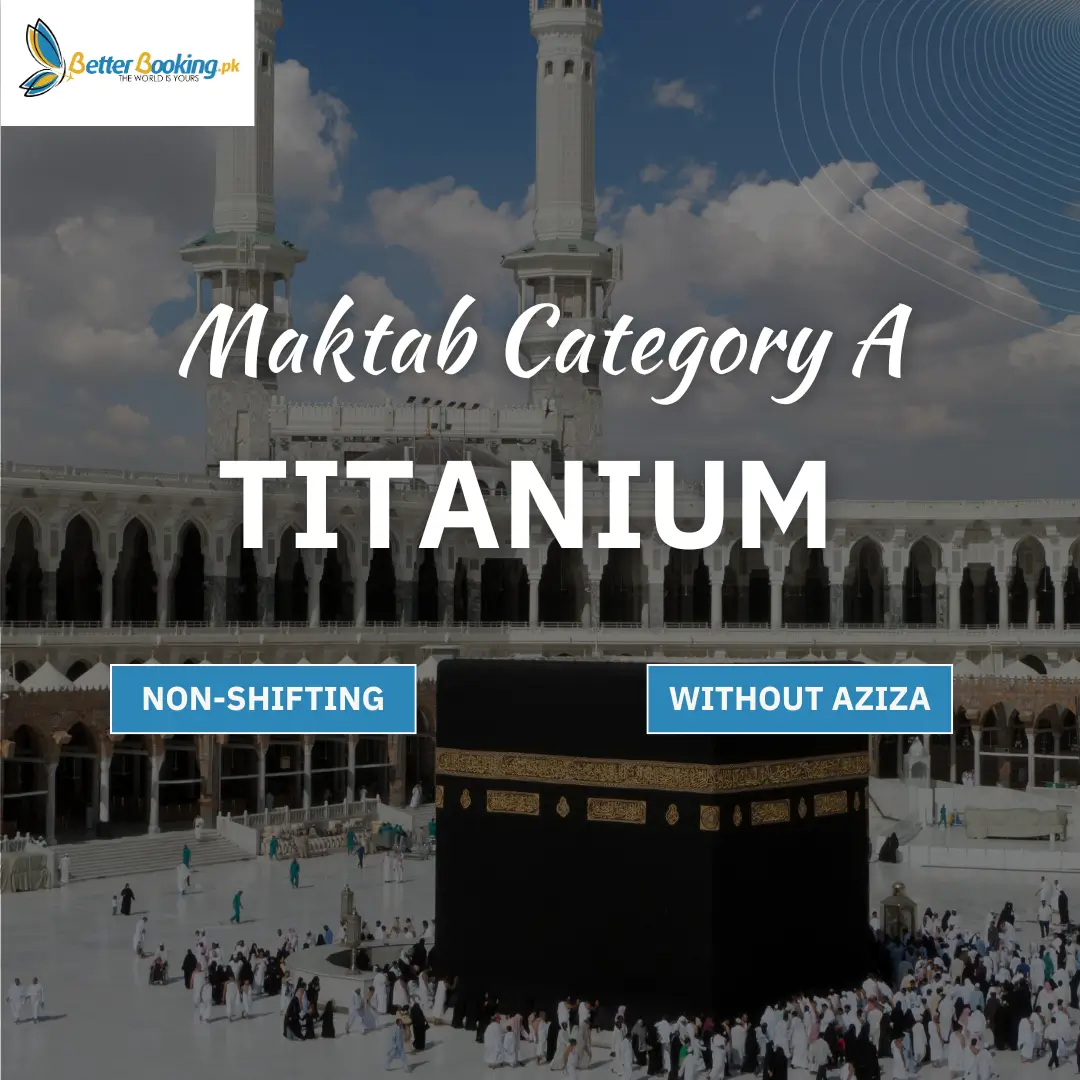Hajj Packages
Better Booking will be offering 15-day, 20-day, 30-day, and 40-day Hajj packages for the year 2024/1445H. Stay tuned for detailed Hajj policies and packages departing from Karachi, Lahore, Multan, Faisalabad, Rawalpindi/Islamabad, Peshawar, and Quetta. Additionally, we offer premium Hajj packages and comprehensive guidance and support for pilgrims from the UK, USA, UAE, and other regions who intend to perform Hajj in 2024/1445H with Better Booking.
Latest Umrah Packages
- One recent passport size color photograph (white background).
- Application form filled in with black ink pen or printed.
- A non-refundable roundtrip ticket with confirmed reservations.
- Proof of vaccination.
- Original passport for scanning.
- Four pictures 3×4 cm (light blue background)
- Blood Group
- Mobile number / Landline number.
- Nominee name (in case of emergency during travelling, must be adult/relative.
Pre-Hajj Meet up
Get to know each other and held ameeting with all the Hajjis
Meet & Assist
A dedicated team to assist and guide
Buffet Meals
Segregated full board buffet food/meals
5 Star Lodgings
Get a comfort living 5 star hotel facility
Visa Acquisition
We facilitate with visa documentation and services
Luxury Transport
We offer luxury busses and private vehicle
Sofa Mattress in Mina
Premium quality sofas and mattress
Guide & Scholar
3 to 4 training sessions with renowned scholars
Need Help?
FAQs
Why are the rituals of Hajj important?
The rituals of Hajj are important because they fulfill a key religious obligation in Islam, symbolizing spiritual purification and forgiveness. They commemorate the actions of Prophet Ibrahim and foster unity among Muslims worldwide. Additionally, they promote moral and ethical growth through lessons in patience, humility, and self-discipline.
What is the most important ritual in Hajj?
The most important ritual in Hajj is the standing at Arafat (Wuquf at Arafat). This occurs on the 9th day of Dhul-Hijjah, where pilgrims gather at the plain of Arafat to pray, repent, and seek forgiveness from Allah. This ritual is considered the pinnacle of Hajj, as the Prophet Muhammad said, “Hajj is Arafat.” Without standing at Arafat, the Hajj is considered incomplete.
What are the significance of Hajj?
Hajj is significant for Muslims as it fulfills a key pillar of Islam, offering spiritual purification and forgiveness of sins. It commemorates the actions of Prophet Ibrahim and promotes unity and equality among Muslims worldwide. The pilgrimage teaches patience, humility, and resilience, often leading to profound personal and spiritual transformation.
What is Hajj when and how it is performed?
Hajj is the annual pilgrimage to Makkah (Mecca) performed by Muslims around the world. It takes place during the Islamic month of Dhul-Hijjah, specifically from the 8th to the 12th or 13th day of the month. The pilgrimage involves several key rituals:
1. **Ihram**: Pilgrims enter a state of consecration (ihram) by wearing special white garments. This state involves spiritual purity and specific behavioral restrictions.
2. **Tawaf**: Pilgrims perform seven circuits around the Kaaba, the sacred cubic structure in the center of the Masjid al-Haram mosque in Makkah.
3. **Sa’i**: Pilgrims walk between the hills of Safa and Marwah seven times, symbolizing Hajar’s (Hagar’s) search for water for her son Ismail (Ishmael).
4. **Wuquf at Arafat**: Pilgrims gather at the plain of Arafat on the 9th day of Dhul-Hijjah, standing in prayer and devotion, seeking Allah’s forgiveness and mercy.
5. **Muzdalifah**: After sunset on the day of Arafat, pilgrims proceed to Muzdalifah, where they perform prayers and collect pebbles for the next ritual.
6. **Rami al-Jamarat**: Pilgrims stone three pillars in the city of Mina, symbolizing the rejection of evil temptations faced by Ibrahim.
7. **Eid al-Adha**: The 10th day of Dhul-Hijjah marks the celebration of Eid al-Adha, where pilgrims sacrifice an animal (usually a sheep or goat) to commemorate Ibrahim’s willingness to sacrifice his son Ismail.
8. **Tawaf al-Ifadah**: Pilgrims return to Makkah to perform another Tawaf around the Kaaba, followed by Sa’i between Safa and Marwah if it’s their first Hajj.
9. **Tawaf al-Wada**: Before leaving Makkah, pilgrims perform a farewell Tawaf around the Kaaba, known as Tawaf al-Wada.
Hajj is a deeply spiritual journey and obligatory once in a lifetime for financially and physically capable Muslims. It is a profound experience of faith, unity, and submission to Allah’s will.
What is Mina and why it’s important to visit and stay in MINA?
Mina is a valley located approximately 5 kilometers east of Makkah in Saudi Arabia. It holds significant importance during the Hajj pilgrimage for several reasons:
1. **Rituals of Hajj**: During Hajj, pilgrims stay in Mina on the 8th, 11th, 12th, and sometimes the 13th day of Dhul-Hijjah. It serves as a site for the ritual of Rami al-Jamarat, where pilgrims throw pebbles at three pillars symbolizing the rejection of temptations faced by Prophet Ibrahim.
2. **Symbolism**: Mina symbolizes the obedience and submission to Allah’s commands. Staying in Mina and performing the rituals there are integral parts of the Hajj pilgrimage, reflecting the faith and dedication of the pilgrims.
3. **Spiritual Reflection**: The time spent in Mina allows pilgrims to focus on prayer, reflection, and repentance. It is a period of spiritual contemplation and devotion, where pilgrims prepare themselves for the culmination of the Hajj pilgrimage.
4. **Community and Unity**: Mina accommodates millions of pilgrims during Hajj, fostering a sense of unity and solidarity among Muslims from diverse backgrounds and nationalities. It reinforces the principle of equality in Islam, as all pilgrims share similar accommodations and experiences during their stay.
In essence, visiting and staying in Mina is crucial for fulfilling the rituals of Hajj and experiencing the spiritual journey that Hajj represents. It is a time for deep spiritual engagement, communal worship, and adherence to the traditions established by Prophet Ibrahim and practiced by Muslims throughout history.
How many days Muslims stay in Mina during Hajj?
Pilgrims spend two or three days in Mina.
How many stones do you throw at Jamarat?
During the Hajj pilgrimage, pilgrims throw seven pebbles at each of the three pillars (Jamarat) in Mina. This ritual, known as “Rami al-Jamarat,” symbolizes the rejection of evil and temptation, replicating Prophet Ibrahim’s act when he was tempted by Satan to disobey Allah’s command. Thus, pilgrims throw a total of 21 pebbles over the course of the ritual.
Hajj do women need Mehram?
Yes, according to Islamic law and Hajj regulations, women typically require a Mahram (a male relative whom she cannot marry due to blood relation or marital status, such as a father, brother, son, uncle, etc.) to accompany them during the Hajj pilgrimage. This requirement ensures the safety, security, and support of women during the journey, as Hajj involves communal living and various rituals that may require assistance or supervision. The presence of a Mahram is generally necessary to fulfill the religious obligations and ensure the well-being of female pilgrims throughout the pilgrimage. But
The Hajj ministry has officially let women to perform the pilgrimage without a male relative or Mehram. This is if they go in a group.
What DUAS to read during Tawaf?
During Tawaf (circumambulation around the Kaaba), Muslims often recite various supplications (Duas) to seek blessings, forgiveness, and guidance. Some common Duas to recite during Tawaf include:
1. **Opening Dua for Tawaf**:
– “Bismillah, Allahu Akbar” (In the name of Allah, Allah is the Greatest)
2. **Prayers for Guidance and Forgiveness**:
– “Rabbana atina fi’d-dunya hasanatan wa fil-akhirati hasanatan waqina ‘adhaban-nar” (Our Lord, give us in this world [that which is] good and in the Hereafter [that which is] good and protect us from the punishment of the Fire.)
3. **Dua for Personal Intentions**:
– Muslims often supplicate to Allah for personal needs, guidance, and blessings during Tawaf, using their own words and heartfelt prayers.
4. **Salutations and Praise**:
– “Subhanallah, Alhamdulillah, Allahu Akbar” (Glory be to Allah, Praise be to Allah, Allah is the Greatest)
5. **Prayers for Loved Ones**:
– Muslims may also pray for their families, friends, and community members, asking Allah for their well-being and guidance.
These Duas and supplications reflect the devotion, humility, and spiritual connection that Muslims seek to cultivate during Tawaf around the Kaaba.
What do you do in Safa and Marwa?
In the pilgrimage of Umrah or Hajj, pilgrims perform Sa’i, which involves walking back and forth seven times between the hills of Safa and Marwa. This ritual commemorates the actions of Hajar (Hagar), the wife of Prophet Ibrahim (Abraham), who ran between these hills in search of water for her son Isma’il (Ishmael) after they were left in the barren desert by divine command.
### Steps of Sa’i:
1. **Start at Safa**: Pilgrims begin at the hill of Safa, where they face the Kaaba and recite supplications (Duas) and praise to Allah.
2. **Walk Towards Marwa**: They then descend and walk towards the hill of Marwa, covering the distance between the two hills, which is approximately 450 meters.
3. **Arrive at Marwa**: Upon reaching Marwa, pilgrims ascend it and face the Kaaba again, repeating the Duas and supplications.
4. **Repeat Seven Times**: This walking between Safa and Marwa is repeated seven times, totaling fourteen rounds (seven between Safa and Marwa and seven back to Safa).
5. **End at Marwa**: After completing the seventh round and arriving at Marwa, pilgrims conclude their Sa’i.
### Significance:
Sa’i symbolizes the perseverance and faith of Hajar and the acceptance of Allah’s will. It is a reminder of reliance on Allah’s mercy and provision in all circumstances. This ritual is integral to both Umrah and Hajj pilgrimages, reflecting a fundamental aspect of Islamic history and spirituality.





